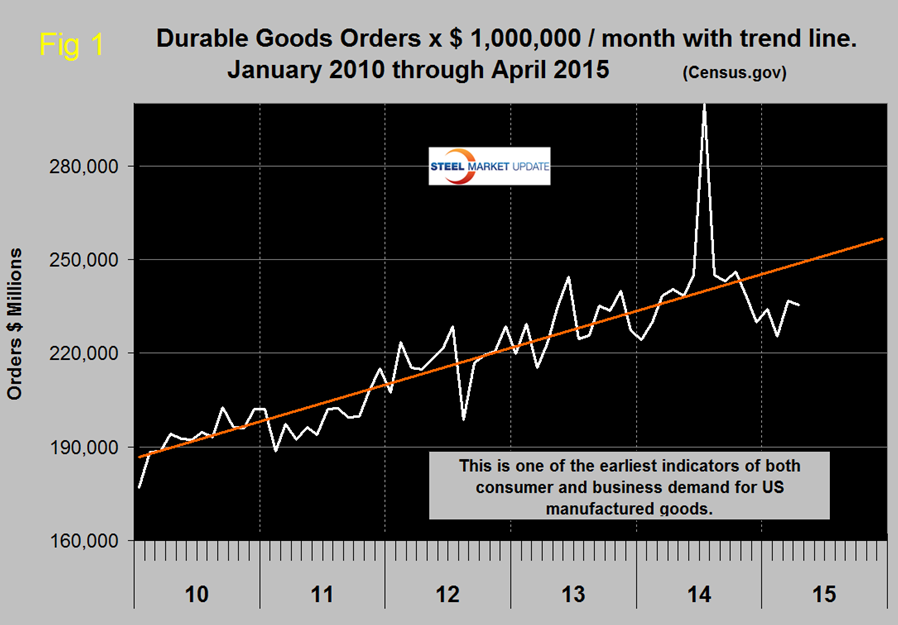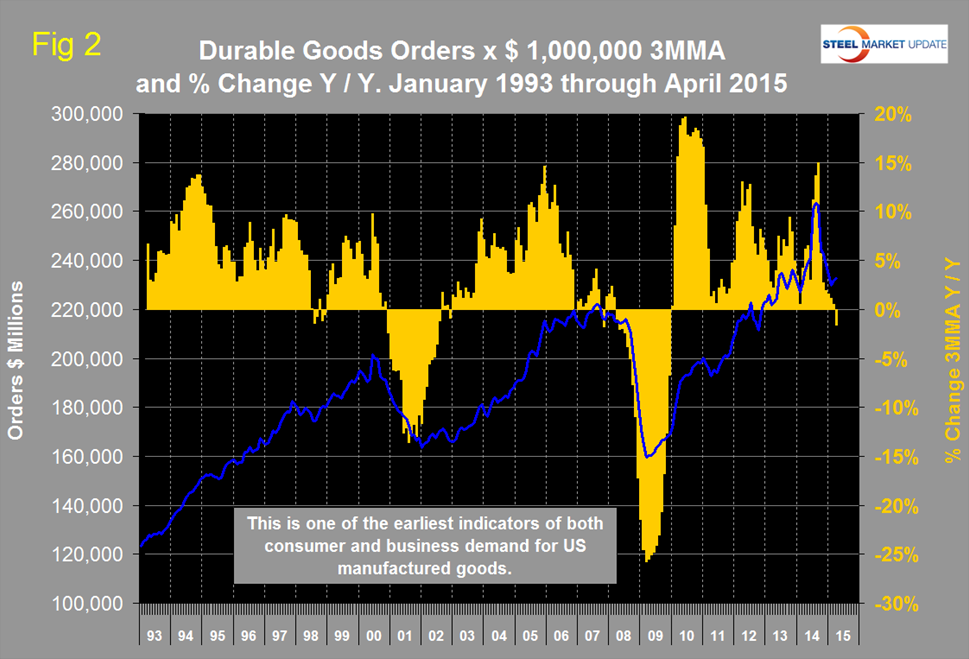Economy

Durable Goods Shipments, Inventories and Orders
Written by Peter Wright
May 26, 2015
New orders for durable goods in April fell by $1.2 billion to $235.5 billion or 0.5 percent from March’s level. This was in line with analysts’ expectations. The three month moving average (3MMA) rose by 0.2 percent. There has been a sharp deviation of the 3MMA from its trend line in the last five months (Figure 1).
The huge spike in August was a manifestation of the surge in civil aircraft orders in July. The three month moving average, is shown in Figure 2 for the period January 1993 through April 2015.
The year over year growth rate of the 3MMA came in at negative 1.6 percent in April, the first negative result since December 2009 when the post recessionary recovery began. The weak April result was driven by orders for civil aircraft. This index is routinely whipsawed by both civil and military aircraft orders but we include it in our steel analyses because it is a reality check for other manufacturing data and is described by the Census Bureau as one of the earliest indicators for US manufactured goods.
The Census Bureau press release issued on Tuesday read as follows:
New Orders for manufactured durable goods in April decreased $1.2 billion or 0.5 percent to $235.5 billion, the U.S. Census Bureau announced today. This decrease, down two of the last three months, followed a 5.1 percent March increase. Excluding transportation, new orders increased 0.5 percent. Excluding defense, new orders increased 0.2 percent. Transportation equipment, also down two of the last three months, drove the decrease, $2.0 billion or 2.5 percent to $77.9 billion.
Shipments of manufactured durable goods in April, down three of the last four months, decreased $0.1 billion or 0.1 percent to $240.5 billion. This followed a 1.5 percent March increase. Primary metals, down six of the last seven months, drove the decrease, $0.5 billion or 2.1 percent to $21.6 billion.
Unfilled Orders for manufactured durable goods in April, down four of the last five months, decreased $0.3 billion, or virtually unchanged, to $1,203.1 billion. This followed a 0.1 percent March increase. Machinery, down six of the last seven months, drove the decrease, $0.9 billion or 0.7 percent to $115.7 billion.
Inventories of manufactured durable goods in April, up twenty-four of the last twenty-five months, increased $0.9 billion or 0.2 percent to $401.5 billion. This was at the highest level since the series was first published on a NAICS basis in 1992 and followed a virtually unchanged March increase. Transportation equipment, up sixteen of the last seventeen months, led the increase, $0.6 billion or 0.5 percent to $130.3 billion.
Non-defense new orders for Capital Goods in April increased $0.3 billion or 0.3 percent to $81.2 billion. Shipments increased $1.3 billion or 1.6 percent to $80.2 billion. Unfilled orders increased $1.1 billion or 0.1 percent to $763.3 billion. Inventories increased $0.3 billion or 0.2 percent to $177.4 billion. Defense new orders for capital goods in April decreased $0.9 billion or 9.5 percent to $8.4 billion. Shipments decreased $0.3 billion or 2.8 percent to $9.5 billion. Unfilled orders decreased $1.0 billion or 0.7 percent to $151.4 billion. Inventories increased $0.5 billion or 2.5 percent to $21.7 billion.

Peter Wright
Read more from Peter WrightLatest in Economy

New York state manufacturing index drops again in April
Firms were pessimistic, with the future general business conditions index falling to its second lowest reading in the more than 20-year history of the survey

Construction adds 13,000 jobs in March
The construction sector added 13,000 jobs, seasonally adjusted, in March, but tariffs could undermine the industry.

Supply chains, end-users brace for impact from tariffs
Supply chains are working through what the tariffs mean for them

ISM: Manufacturing expansion loses steam after two months of growth
US manufacturing activity slowed in March after two straight months of expansion, according to supply executives contributing to the Institute for Supply Management (ISM)’s latest report.

Chicago Business Barometer rose to 16-month high in March
The Chicago Business Barometer increased for the third-consecutive month in March. Despite this, it still reflects contracting business conditions, as it has since December 2023.


